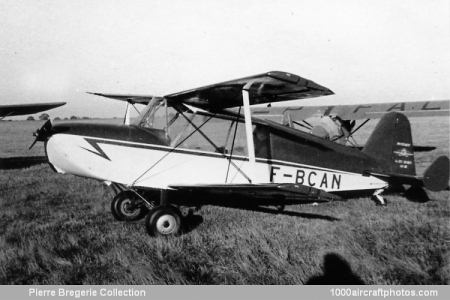The single-seat biplane LD 45, MDG's first aircraft, was designed by Louis Delasalle, who's creations have been built by a number of small firms. The
LD 45 was built by SECAT (Société d'Études et de Constructions d'Avions de Tourisme), and was exhibited at the 1946 Paris Air Show.
Developed from the LD 45 was the two-seat LD 26 Midget Club of mixed construction, the design was inspired by the 1947 SALS light sports aircraft competition and was one of some nineteen designs to enter.
Built by MDG the first LD 26, registered as F-WEAM (later F-BEAM c/n 01) and powered by a 60 hp Praga D engine, was flown on November 16, 1947. It became the LD 261 when re-engined with a 65 hp Continental A65 engine, and featuring small auxiliary end plates at the horizontal tail. Reportedly three additional aircraft were built, including the pictured aircraft (later reregistered F-PCAN) and F-BCAO.
Wings: Single-bay staggered biplane. Clark wing section. Aspect ratio 9.15. Four wing panels of equal area, the upper panels attached to welded tube cabane and the lower panels to sides of fuselage. Upper and lower panels on each side interchangeable. Single I-strut on each side. Dihedral 1° 5' upper, 3° 5' lower. Single spar structure with plywood covering. Entire trailing edges hinged, slotted flaps on upper wings, slotted ailerons on lower wings. Flaps spring-loaded and automatic.
Fuselage: Main structure rectangular light alloy stressed skin "girder," the rear half surmounted by an inverted V-supertructure extending from fin to the tubular cabane supporting the upper wings and enclosing the cabin.
Tail unit: Rigidly-braced tail plane and cantilever fin. Statically-balanced elevators interchangeable. All-wood fin and rudder.
Landing gear: Fixed type. Two streamline legs rigidly braced forwards and transversely. Rubber-in-compression springing enclosed in wheels. Steerable tail wheel with rubber-in-compression springing. Mechanical wheel-brakes.
Power plant: One 65 hp Continental A65 four-cylinder horizontally-opposed air-cooled engine. Fuel capacity 15.85 gal (60 l).
Accommodation: Enclosed cabin seating two in staggered seats. Two large jettisonable doors. Front, sides and roof of cabin with transparent panels for all-round visibility. Central control column with extensions for each seat. Dual rudder pedal and brake control. Instrument panel with blind-flying equipment optional."
